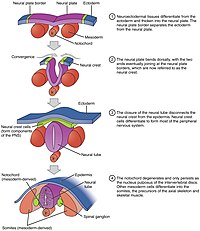
Photo from wikipedia
Existing therapies against myocardial infarction (MI) involve disease management by preventing additional damage to the heart muscle. However, new treatment strategies are in greater demand, which deems to focus on… Click to show full abstract
Existing therapies against myocardial infarction (MI) involve disease management by preventing additional damage to the heart muscle. However, new treatment strategies are in greater demand, which deems to focus on restoring cardiac function by replacing the damaged cells after MI, rather than merely manage the disease. Cardiosphere-derived cells (CDCs) have emerged as a potential source of cardiac regenerative therapy. In spite of being a promising option, the poor differentiation potential of CDCs to develop into a functional population of cardiomyocytes has always been a significant setback. The purpose of the present study centers to overcome the aforementioned setback by enhancing the efficiency of rat CDCs to develop into a large population of cardiomyocytes by intrinsic activation of cardio-specific differentiation factors (TNNT2, GATA4, Mef2c) by Crispr/dcas9 assisted transcriptional enhancement system. In the foremost step, an exhaustive screening was performed to identify the specific sequences in endogenous regulatory regions (enhancers and promoters) responsible for transcriptional activation of the TNNT2 gene. Once, potential regulatory regions at proximal and distal end of TNNT2 were identified, crRNAs were designed complementing these regions for recruiting Crispr/dcas9 system fused with transcriptional activator like VP64 (CRISPR-dCas9-VP64). Two distinct plasmids were constructed with crRNA (RFP fused) inserts and CRISPR-dCas9-VP64 (GFP fused) followed by transfection in CDCs those isolated from the heart of a neonatal rat. Post transfection, CDCs were then analyzed for the quantitative expression of cardiomyocyte differentiation factors as well as for fibroblast differentiation factors in comparison with un-transfected CDCs. We identified a panel of specific crRNA targeting the enhancers and promoters which demonstrated significantly higher expression of differentiation factors like troponin, GATA4, and Mef2c. Further, the fluorescent visualization with GFP and RFP was prominent in the CDCs confirming that these panel of crRNA enhanced the expression of differentiation factors compared to the un-transfected counterparts. Interestingly, the same panel crRNA, in contrast, demonstrated diminished expression of fibroblast differentiation factors like Col1A1, clearly emphasizing that the CRISPR dCas9 system recruitment at regulatory regions forms an efficient molecular targeting system for enhancing the differentiation potential of CDCs into cardiomyocytes. We have identified endogenous regulatory regions responsible for an intrinsic activation of cardio-specific differentiation factors assisted by Crispr/dcas9 gene transcriptional system. We anticipate the method developed herein can enhance and cardiomyogenic efficiency of CDCs to differentiate into a large population of cardiomyocytes to treat Ischemic heart diseases.
Journal Title: European Heart Journal
Year Published: 2019
Link to full text (if available)
Share on Social Media: Sign Up to like & get
recommendations!